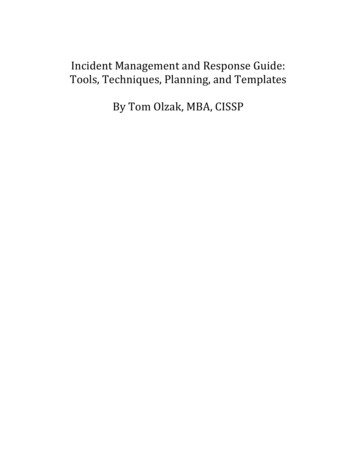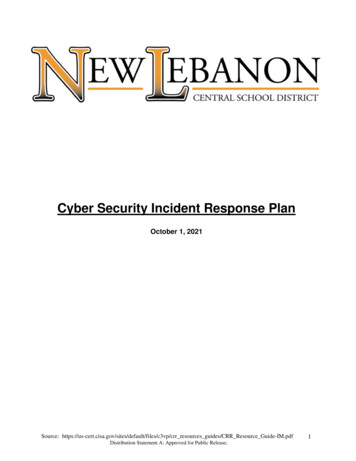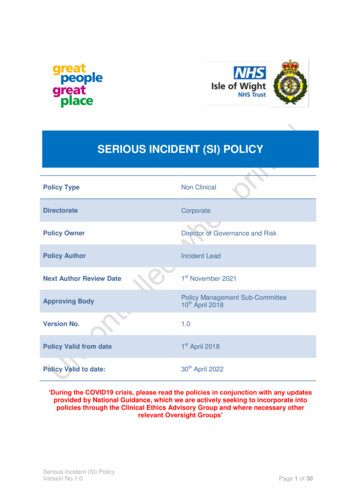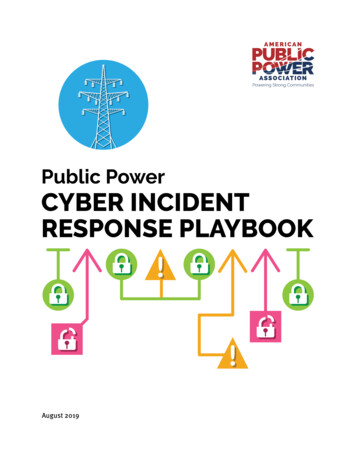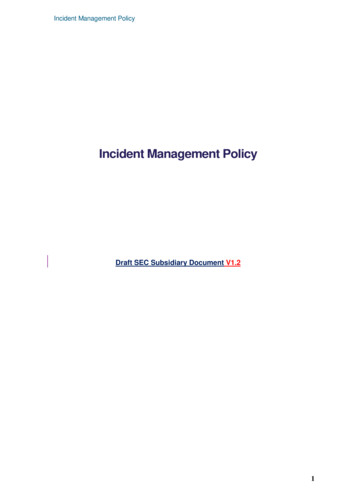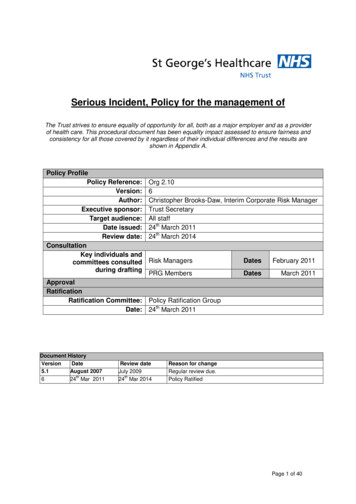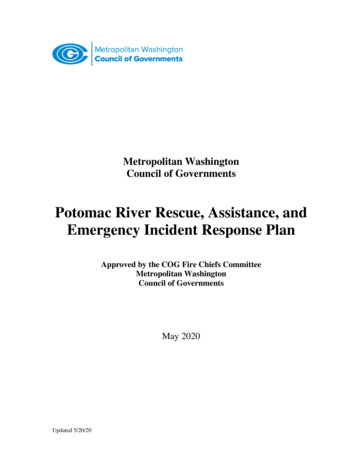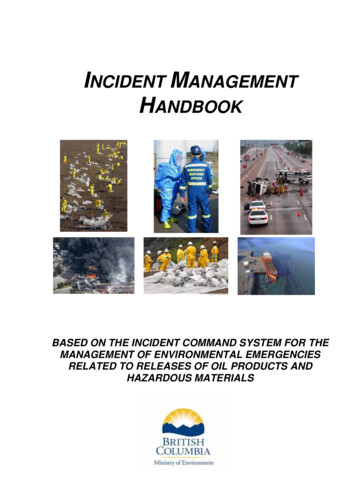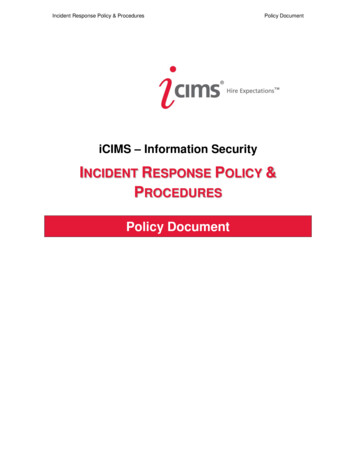
Transcription
Incident Response Policy & ProceduresPolicy DocumentiCIMS – Information SecurityINCIDENT RESPONSE POLICY &PROCEDURESPolicy Document
Incident Response Policy & ProceduresPolicy Document1. DOCUMENT PURPOSE1.1. This document defines the policy for addressing Security Incidents through appropriateIncident Response.1.2. This document applies to all Personnel and supersedes all other policies relating to thematters set forth herein.Page 1
Incident Response Policy & ProceduresPolicy Document2. TERMS & DEFINITIONSTerm/AcronymDefinitionData BreachA Security Incident that directly impacts Personal Data, Sensitive PersonalInformation or Personally Identifiable Information.Means the person or organization that determines the purpose and means of theProcessing of Personal Data.The engagement of additional resources to resolve a Security Incident.Data ControllerEscalationIncident ResponseManagementInformation Security/IncidentPersonal DataPersonnelSecurity EventSecurity IncidentSecurity Incident Response Team(SIRT)Security VulnerabilitySecurity WeaknessProcess for detecting, reporting, assessing, responding to, dealing with, and learningfrom Security Incidents.Preservation of confidentiality, integrity, and availability of Information and theequipment, devices or services containing or providing such Information.Means any information relating to an identified or identifiable Data Subject, wheresuch information is protected under applicable law. For clarity, Personal Data includesany SPD, SPI, and/or Tracking Data that directly or indirectly identifies a Data Subject.iCIMS employees (part and full time) and interns.An identified occurrence of a system, service or network state indicating a possiblebreach of information security policy, a possible exploitation of a Security Vulnerabilityor Security Weakness or a previously unknown situation that can be security relevant.A single or series of unwanted or unexpected Security Events that compromisebusiness operations with an impact on Information Security.A predefined group of individuals needed and responsible for responding to a SecurityIncident, managed by the Information Security Department. During a SecurityIncident, the SIRT is responsible for communication with and coordination of otherinternal groups.A weakness of an existing asset or control that can be exploited by one or morethreats.A weakness that results from the lack of an existing, necessary control.Page 2
Incident Response Policy & ProceduresPolicy Document3. SCOPEThe objective of this policy is to ensure a consistent and effective approach to the managementof Security Incidents, including the identification and communication of Security Events andSecurity Weaknesses.4. INCIDENT RESPONSE POLICYThe Incident Response policy is as follows: Management responsibilities and procedures should be established to ensure a quick,effective, and orderly response to Security Incidents. The objectives for Security Incident management should be agreed upon withmanagement, and it should be ensured that those responsible for Security Incidentmanagement understand the organization’s priorities for handling Security Incidents. Security Events should be reported through appropriate management channels as quicklyas possible. Personnel and contractors using the organization’s information systems and services arerequired to note and report any observed or suspected Security Weakness in systems orservices. Security Events should be assessed and it should be decided if they are to be classifiedas Security Incidents. Security Incidents should be responded to in accordance with documented IncidentResponse procedures. Knowledge gained from analyzing and resolving Security Incidents should be used toreduce the likelihood or impact of future incidents. Procedures should be defined and applied for the identification, collection, acquisition, andpreservation of information, which can serve as evidence. Awareness should be provided on topics such as:ooooThe benefits of a formal, consistent approach to Incident Management (personaland organizational);How the program works, expectations;How to report Security Incidents, who to contact;Constraints imposed by non-disclosure agreements.Page 3
Incident Response Policy & Procedures Communication channels should be established well in advance of a Security Incident.Include all necessary parties in relevant communication:ooo Policy DocumentSIRT membersSenior ManagementiCIMS PersonnelIn the event a Security Incident, Data Controllers, government bodies and other necessaryparties should be notified in a reasonable timeframe, and in compliance with regulatoryand other applicable requirements and guidance.Page 4
Incident Response Policy & ProceduresPolicy DocumentiCIMS – Information SecurityINCIDENT RESPONSE PROCEDURESProcess DocumentPage 5
Incident Response Policy & ProceduresPolicy Document5. DOCUMENT PURPOSE1.3.The purpose of this document is to define the Incident Response procedures followedby iCIMS in the event of a Security Incident. This document is a step-by-step guide ofthe measures Personnel are required to take to manage the lifecycle of SecurityIncidents within iCIMS, from initial Security Incident recognition to restoring normaloperations. This process will ensure that all such Security Incidents are detected,analyzed, contained and eradicated, that measures are taken to prevent any furtherSecurity Incidents, and, where necessary or appropriate, that notice is provided to lawenforcement authorities, Personnel, and/or affected parties.1.4.This document applies to all Personnel and supersedes all other procedures,practices, and guidelines relating to the matters set forth herein.6. TERMS & DEFINITIONSTerm/AcronymDefinitionAbnormal ActivitiesUnsuccessful attacks that appear particularly significant based on iCIMSunderstanding of the risks it faces.A Security Incident that directly impacts Personal Data, Sensitive PersonalInformation or Personally Identifiable Information.Means the person or organization that determines the purpose and means of theProcessing of Personal Data.The engagement of additional resources to resolve or provide the status regarding aSecurity Incident.General Counsel’s OfficeCreated at the time a Security Incident is initially recognized. Contains all relevantinformation pertaining to the Security Incident.Process for detecting, reporting, assessing, responding to, dealing with, and learningfrom Security Incidents.Data BreachData ControllerEscalationGCOIncident RecordIncident ResponseManagement/IncidentInformation SecurityPreservation of confidentiality, integrity, and availability of Information and theequipment, devices or services containing or providing such Information.Personal DataMeans any information relating to an identified or identifiable Data Subject, wheresuch information is protected under applicable law. For clarity, Personal Data includesany SPD, SPI, and/or Tracking Data that directly or indirectly identifies a Data Subject.Means any information about a Data Subject, whether in paper, electronic, or otherform, which can be used to distinguish or trace an individual’s identity, such as name,email address, or telephone number.iCIMS employees (part and full time) and interns.Personally Identifiable Information(PII)PersonnelSecurity EventSecurity IncidentSecurity Incident Response Team(SIRT)Sensitive Personal Information (SPI)Security VulnerabilitySecurity WeaknessAn identified occurrence of a system, service or network state indicating a possiblebreach of information security policy, a possible exploitation of a Security Vulnerabilityor Security Weakness or a previously unknown situation that can be security relevant.A single or series of unwanted or unexpected Security Events that compromisebusiness operations with an impact on Information Security.A predefined group of individuals needed and responsible for responding to a SecurityIncident, managed by the Information Security Department. During a SecurityIncident, the SIRT is responsible for communication with and coordination of otherinternal groups.Means specific standalone PII or a combination of information that could identify,trace, or locate a Data subject, which if lost, compromised, or disclosed withoutauthorization, could result in substantial harm, embarrassment, inconvenience, orunfairness to an individual.A weakness of an existing asset or control that can be exploited by one or morethreats.A weakness that results from the lack of an existing, necessary control.Page 6
Incident Response Policy & ProceduresPolicy DocumentPage 7
Incident Response Policy & ProceduresPolicy Document7. SCOPEThis document covers the Incident Response process for all identified Security Incidents.The following activities will be covered: Detection Analysis Containment Eradication Recovery Post-Incident ActivitiesThe Incident Response process is considered complete once Information confidentiality, integrity,and/or availability are restored to normal and verification has occurred.8. OVERVIEW8.1.Roles and ResponsibilitiesIndividuals needed and responsible for responding to a Security Incident make up the SIRT.Core members will include the following: Director, Information Security (SIRT Primary Lead) Assistant General Counsel & Director, Legal & Compliance (SIRT SecondaryLead) Security team staff Information ownerOther groups and/or individuals that may be needed include: Senior management General Counsel’s Office (GCO) Human Resources (Talent) End User Support ISS or Dev Ops Staff Building and/or facilities management staff Other Personnel involved in the Security Incident or needed for resolution Contractors (as necessary) Communications ResourcesPage 8
Incident Response Policy & ProceduresPolicy Document9. PROCESS9.1.Detection PhaseIn the detection phase the SIRT, or an internal or external entity, identifies a Security Eventthat may be the result of a potential exploitation of a Security Vulnerability or a SecurityWeakness, or that may be the result of an innocent error.Immediately upon observation or notice of any suspected Security Event, Personnel shall usereasonable efforts to promptly report such knowledge and/or suspicion to the InformationSecurity Department at the following address: Email: InformationSecurity@icims.comA Security Event may be discovered in many ways, including the following: Observation of suspicious behavior or unusual occurrences; Lapses in physical or procedural security; Information coming into the possession of unauthorized Personnel or Third Parties; Information inappropriately exposed on a publicly facing website.To assess whether a Security Event must be reported, Personnel should consider whetherthere are indications that: Information was used by unauthorized Personnel or Third Parties;Page 9
Incident Response Policy & ProceduresPolicy Document Information has been downloaded or copied inappropriately from iCIMS'scomputer systems or equipment; Equipment or devices containing Information have been lost or stolen; Equipment or devices containing Information have been subject to unauthorizedactivity (e.g., hacking, malware). Personal Data has been publicly exposedIn addition, the following situations should be considered for Security Event reporting: Ineffective security controls; Breach of information integrity, confidentiality or availability expectations; Human errors (innocent or otherwise); Non–compliance with policies or standards; Breaches of physical security arrangements; Uncontrolled systems changes; Malfunctions of software or hardware; Access violations.Even if Personnel are not sure whether a Security Event is an actual Security Incident theyare still required to report it as provided herein, as it is better to be cautious than to becompromised.The SIRT will usually require the reporter to supply further information, which will depend uponthe nature of the Security Event. However, the following information normally shall besupplied: Contact name and information of person reporting the Security Event; Date and time the Security Event occurred or was noticed; Type and circumstances of the Security Event; The type of data, information, or equipment involved; Location of the Security Event, data or equipment affected; Whether the Security Event puts any person or other data at risk; and Any associated ticket numbers, emails or log entries associated with the SecurityEvent.SIRT Primary Lead will ensure that the SIRT is promptly engaged once such notice isreceived. The following actions will also be taken:1. The SIRT, under the leadership of the SIRT Primary Lead, shall use reasonableefforts to analyze the matter within four (4) hours of notice and decide whether toproceed with the Analysis Phase of the Incident Response Procedures.P a g e 10
Incident Response Policy & ProceduresPolicy Documenta. Determination to initiate the Analysis Phase must be made quickly sothat Personnel can make an initial determination as to the urgency andseriousness of the situation.2. Upon making the decision to begin the Analysis Phase, if the SIRT suspects thatthe Security Event may result in damage to the reputation of iCIMS or legal liability,the GCO shall initiate a legal assessment of actual or potential legal issues.P a g e 11
Incident Response Policy & Procedures9.2.Policy DocumentAnalysis PhaseThe initial response to detection of a Security Event is typically the Analysis Phase. In thisphase the SIRT determines whether or not a Security Event is an actual Security Incident. Todetermine if a Security Event is a Security Incident the following considerations apply:1. Leverage diagnostic data to analyze the Security Event using tools directly on theoperating system or application. This may include, but not be limited to:(i) Taking screenshots, memory dumps, consult logs and network traces;(ii) Performing analysis on the information being collected;(iii) Analyzing the precursors and indications;(iv) Looking for correlating information; and(v) Performing research (e.g., search engines, knowledgebase).2. Identify whether the Security Event was the result of an innocent error, or theactions of a potential attacker. If the latter, effort shall be made to identify who thepotential attacker may be, by:(i) Validating the attacker's IP address;(ii) Researching the attacker through search engines;(iii) Using incident databases;(iv) Monitoring attacker communication channels, if possible; and(v) In unique cases, and with the approval of legal counsel, potentiallyscanning the attacker's system.If the SIRT has determined that a Security Event has triggered a Security Incident, theappropriate SIRT team members will be engaged accordingly and the SIRT will begindocumenting the investigation and gathering evidence. The type of Security Incident is basedon the nature of the event. Example types are listed as follows:1. Data exposure.2. Unauthorized access.3. Distributed Denial of Service/ Denial of Service (DDoS/DoS).4. Malicious code.5. Improper usage.6. Scans/Probes/Attempted access.If it is determined that a Security Incident has not been triggered, additional activities notedunder ‘5.6. Post-Incident Activities’ may be initiated under the direction of the SIRT.The Security Incident’s potential impact on iCIMS and/or its subscribers shall be evaluatedand the SIRT shall assign an initial severity classification of low, medium, high or critical tothe Security Incident. To analyze the situation, scope, and impact, the SIRT shall:1. Define and confirm the severity level and potential impact of the Security Incident.P a g e 12
Incident Response Policy & ProceduresPolicy Document2. Identify which resources have been affected and forecast which resources will beaffected.3. Estimate the current and potential effect of the Security Incident.The SIRT shall attempt to determine the scope of the Security Incident and verify if theSecurity Incident is still ongoing. Scoping the Security Incident may include collecting forensicdata from suspect systems or gathering evidence that will support the investigation. It mayalso include identifying any potential data theft or destruction. New investigative leads may begenerated as the collected data is analyzed. If the Security Incident involves malware, theSIRT shall analyze the malware to determine its capabilities and potential impact to theenvironment. Based on the evidence reviewed, the SIRT will determine if the Security Incidentrequires reclassification as to its severity or cause (e.g., whether it was originally thought tobe the action of a malicious actor but turned out to be an innocent error, or vice versa).As indicated above, a Security Incident may require evidence to be collected. The collectionof such evidence shall be done with due diligence and the following procedures shall apply:1. Gathering and handling of evidence (forensics) shall include:(i) Identifying information (e.g., the location, serial number, model number,hostname, media access control (MAC) address, and IP address of acomputer);(ii) Name, title, and phone number of everyone who collected or handled theevidence during the investigation;(iii) Time and date (including time zone) of each occurrence of evidencehandling;(iv) Locations where the evidence was stored, and conditions of storage (e.g.,locked spaces, surveilled spaces); and(v) Reasonable efforts to create two backups of the affected system(s) usingnew, unused media — one is to be sealed as evidence and one is to beused as a source of additional backups.2. To ensure that evidence is not destroyed or removed, where any Personnel aresuspected of being responsible for a Security Incident, iCIMS shall, consistent withits procedures, use reasonable efforts to place monitoring and forensics agentsand/or confiscate all computer/electronic assets that have been assigned to him orher.(i) This task may be done surreptitiously, and should be completed as quicklyand in as non-intrusive a manner as possible.(ii) The SIRT should consider restricting access to the computers and attachedperipherals (including remote access via modem, secure remote systemaccess, etc.) pending the outcome of its examination.3. Where applicable, and depending upon the seriousness of the Security Incident,items and areas that should be secured and preserved in an “as was” conditioninclude:(i)Work areas (including wastebaskets);(ii)Computer hardware (keyboard, mouse, monitor, CPU, etc.);P a g e 13
Incident Response Policy & ProceduresPolicy Document(iii)Software;(iv)Storage media (disks, tapes, removable disk drives, CD ROMs, etc.);(v)Documentation (manuals, printouts, notebooks, notepads);(vi)Additional components as deemed relevant (printer, cables, etc.);(vii)In cases of damage, the computer system and its surrounding area, aswell as other data storage devices, should be preserved for the potentialcollection of evidence (e.g., fingerprinting);(viii)If the computer is “Off”, it should not be turned “On”. For a stand-alonecomputer system, if the computer is “On”, the Information Security andIT Departments are to be contacted.4.It is important to establish who was using the computer system at the time of theSecurity Incident and/or who was in the immediate area. The SIRT should obtaincopies of applicable records (e.g., access logs, swipe card logs, closed circuittelevision (“CCTV”) recordings) as part of the investigation.5.Based on the severity level and the categorization of the Security Incident, theproper team or Personnel shall be notified and contacted by the SIRT.6.Until the SIRT, with the approval of iCIMS management, makes the SecurityIncident known to other Personnel, the foregoing activities shall be keptconfidential to the extent possible.If it is determined that a Security Incident has occurred and may have a significant impact oniCIMS or its subscribers, the SIRT shall determine whether additional resources are requiredto investigate and respond to the Security Incident. The extent of the additional resources willvary depending on the nature and significance of the Security Incident.Abnormal Activities Notification:The SIRT recognizes that there may be many attempts to gain unauthorized access to, disruptor misuse information systems and the information stored on them, and that many of theseattempts will be thwarted by iCIMS’ information security program. In general, the SIRT will notreport unsuccessful attacks to customers. For example, the SIRT would generally not berequired to report to a Data Controller or customer if it makes a good faith judgment that theunsuccessful attack was of a routine nature.However, the SIRT will take reasonable steps to notify customers or Data Controllers of anyidentified Abnormal Activities. For example, in making a judgment as to whether a particularunsuccessful attack should be reported, iCIMS might consider whether handling the attackrequired measures or resources well beyond those ordinarily used, like exceptional attentionby senior personnel or the adoption of extraordinary non-routine precautionary steps. In casesof identified Abnormal Activities, the Data Controller or customer would be notified by meansagreed upon by iCIMS and the Data Controller or customer within twenty-four (24) hours uponiCIMS becoming aware of the Abnormal Activity.Data Breach Notification:P a g e 14
Incident Response Policy & ProceduresPolicy DocumentIf it is determined during the analysis phase that a Security Incident has occurred thatconstitutes a Data Breach, with notification obligations based on regulatory, legal, or similarrequirements, notification of such Data Breach shall be provided to the impacted DataController by email, telephone, or other means agreed upon by iCIMS and the Data Controller,within twenty-four (24) hours upon iCIMS becoming aware of the Data Breach. Additionalactivities noted under ‘5.6. Post-Incident Activities’ may also be initiated under the directionof the SIRT.9.3.Containment PhaseThe Containment Phase mitigates the root cause of the Security Incident to prevent furtherdamage or exposure. This phase attempts to limit the impact of a Security Incident prior toan eradication and recovery event. During this phase, the SIRT may implement controls, asnecessary, to limit the damage from a Security Incident. If a Security Incident is determinedto be caused by innocent error, the eradication phase may not be needed. For example, afterreviewing any information that has been collected investigating the Security Incident the SIRTmay:1. Secure the physical and network perimeter.i. For example, shutting down a system, disconnecting it from the network,and/or disabling certain functions or services.2. Connect through a trusted connection and retrieve any volatile data from theaffected system.3. Determine the relative integrity and the appropriateness of backing the system up.4. If appropriate, back up the impacted system.5. Change the password(s) to the affected system(s). Personnel, as appropriate,shall be notified of the password change.6. Determine whether it is safe to continue operations with the affected system(s).i. If it is safe, allow the system to continue to function, in which case the SIRTwill:a. Update the Incident Record accordingly; andb. Move to the Recovery Phase.ii. If it is not safe to allow the system to continue operations, the SIRT willdiscontinue the system(s) operation and move to Eradication Phase.iii. The SIRT may permit continued operation of the system under closesupervision and monitoring if:1. Such activity will assist in identifying individuals responsible for theSecurity Incident;2. The system can run normally without risk of disruption, compromiseof data, or serious damage; and3. Consensus has been reached within the SIRT before taking thesupervision and monitoring approach.7. The final status of this stage should be appropriately documented in theIncident Record.P a g e 15
Incident Response Policy & ProceduresPolicy Document8. The SIRT shall apprise senior management of the progress, as appropriate.During the Analysis and Containment Phases, the SIRT shall keep notes and use appropriatechain of custody procedures to ensure that the evidence gathered during the Security Incidentcan be used successfully during prosecution, if appropriate.P a g e 16
Incident Response Policy & Procedures9.4.Policy DocumentEradication PhaseThe Eradication Phase is the phase where vulnerabilities causing the Security Incident, andany associated compromises, are removed from the environment. An effective eradicationfor a targeted attack removes the attacker’s access to the environment all at once, during acoordinated containment and eradication event. Although the specific actions taken during theEradication Phase can vary depending on the Security Incident, the standard process for theEradication Phase shall be as follows:1. Determine the symptoms and cause related to the affected system(s).2. Eliminate components of the Security Incident. This may include deleting malware,disabling breached user accounts, etc.3. Strengthen the controls surrounding the affected system(s), where possible (a riskassessment will be performed, if needed). This may include the following:i. Strengthening network perimeter defenses.ii. Improving monitoring capabilities or scope.iii. Remediating any security issues within the affected system(s), such asremoving unused services or implementing general host hardeningtechniques.iv. Conduct a vulnerability assessment to verify that all the holes/gaps that canbe exploited have been addressed.4. If additional issues or symptoms are identified, take appropriate preventativemeasures to eliminate or minimize potential future compromises.5. Update the Incident Record with the information learned from the vulnerabilityassessment, including the cause, symptoms, and method used to fix the problemwith the affected system(s).6. If necessary, escalate to higher levels of support to enhance capabilities,resources, or time-to-eradication.7. Apprise senior management of progress, as appropriate.After iCIMS has implemented the changes for eradication, it is important to verify that cause ofand individual(s) causing the Security Incident is fully eradicated from the environment. TheSIRT shall also test the effectiveness of any security controls or changes that were made to theenvironment during containment and eradication.P a g e 17
Incident Response Policy & Procedures9.5.Policy DocumentRecovery PhaseThe Recovery Phase represents the SIRT’s effort to restore the affected system(s) tooperation after the problems that gave rise to the Security Incident, and the consequences ofthe Security Incident, have been corrected. Recovery events can be complex depending onthe Security Incident type and can require full project management plans to be effective.Although the specific actions taken during the Recovery Phase can vary depending on theidentified Security Incident, the standard process to accomplish this shall be as follows:1. Execution of the following actions, as appropriate: Installing patches. Rebuilding systems. Changing passwords. Restoring systems from clean backups. Replacing affected files with clean versions.2. Determination whether the affected system(s) has been changed in any way.a. If the system(s) has been changed, the system is restored to its proper,intended functioning (“last known good”).i. Once restored, the system functions are validated to verify that thesystem/process functions as intended. This may require the involvement ofthe business unit that owns the affected system(s).ii. If operation of the system(s) had been interrupted (i.e., the system(s) hadbeen taken offline), it should be restored and validated, and the system(s)should be monitored for proper behavior.b. If the system(s) has not been changed in any way, but was taken offline (i.e.,operations had been interrupted), restart the system and monitor for properbehavior.3. Implementation of additional monitoring and alerting may be done to identify similaractivities.4. Update the Incident Record with any details determined to be relevant during thisphase.5. Apprise senior management of progress, as appropriate.P a g e 18
Incident Response Policy & Procedures9.6.Policy DocumentPost-Incident ActivitiesIn addition to the Data Breach and Abnormal Activities notification requirements identified inthe analysis phase above, and after verification of a successful containment and anynecessary eradication, the SIRT shall take the following post-incident activities, as may benecessary:I.CommunicationsA.NotificationWhen warranted or required by judicial action, law, or regulation, iCIMS shall usereasonable efforts to provide notice to Personnel and/or affected parties about aSecurity Incident involving the Sensitive and/or Confidential Information of suchstakeholders. For example:1. Where it has been determined, or the SIRT and management reasonablybelieve, that there has been unauthorized access to or release of unencryptedcustomer data;2. Where the Security Incident has compromised the security, confidentiality orintegrity of Confidential Information.Upon deciding to notify the SIRT, in consultation with senior management, shalluse reasonable efforts to provide notice and disclosure to Personnel and/oraffected parties within twenty-four (24) hours and, subject to applicable law, priorto notification of law enforcement personnel. Delay may nonetheless occur ininstances where it is mandated or authorized by applicable law. For example,disclosure might be delayed if notice would impede a criminal investigation or iftime is required to restore reasonable integrity to iCIMS's information systems.If appropriate, the SIRT may:1. Prepare a general notice and arrange for providing the notice to Personneland/or affected parties;2. Prepare a FAQ based on the
Incident Response Policy & Procedures Policy Document Page 3 3. SCOPE The objective of this policy is to ensure a consistent and effective approach to the management of Security Incidents, including the identification and communication of Security Events and Security Weaknesses. 4. INCIDENT RESPONSE POLICY
